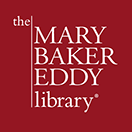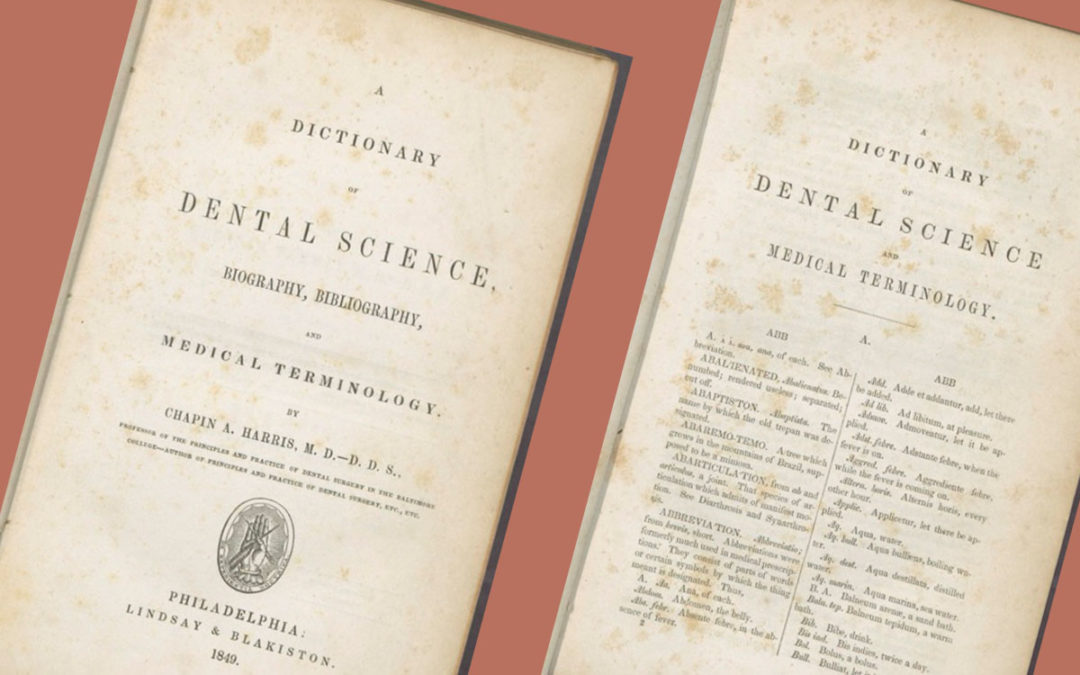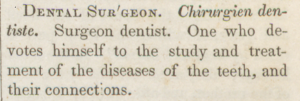Daniel Patterson owned a copy of this book about dental and medical terminology: A Dictionary of Dental Science, Biography, Bibliography, and Medical Terminology by Chapin A. Harris (Philadelphia: Lindsay and Blakiston, 1849).
The earliest records of Mary Baker Eddy receiving dental work date from correspondence with dentist Daniel Patterson. In January 1853 she wrote to him about problems she was having with her partial dentures, which were in need of repair. She concluded her letter, “Yours in Toothless Trouble, Mary.”1 She married Patterson less than six months later.
As the years passed, Eddy continued to have teeth extracted, and her dentures improved. She visited three other dental surgeons in the years after she had separated from and then divorced Patterson (mainly from the 1890s forward): Dr. Eugene A. Rowe, Dr. Henry F. Libby, and Dr. John M. Fletcher. Each of these men provided various services, mainly along the lines of tooth extractions and denture improvements.
A nineteenth-century definition of a dental surgeon. Eddy requested the assistance of these professionals throughout her life. Harris, A Dictionary of Dental Science and Medical Terminology, 177.
By 1905 Eddy had a complete set of false teeth, Dr. Rowe having removed her last tooth on October 16.2
This quotation from A Dictionary of Dental Science and Medical Terminology—a book that Patterson owned—spoke to the importance of false teeth in those days:
ARTIFICIAL TEETH. Contributing as the teeth do, to the beauty and pleasing expression of the countenance; to correct enunciation, and by the function of mastication which they are the chief agents in performing, to the health of the whole organism, it is not surprising that their loss should be considered a serious affliction, and that art should be invoked to replace such loss with artificial substitutes….3
Regarding statements by Eddy about dentistry, her article “Christian Science and the Episcopal Congress” appeared in the January 1901 issue of The Christian Science Journal. It had been originally published in The Boston Herald on December 2, 1900. A section of the article details Eddy’s experiences with Dr. Fletcher and her thoughts on Christian Science and dentistry. (Fletcher himself also contributed to the article.):
Those familiar with my writings know that long ago I instructed Christian Scientists not to interfere with methods of surgery, but if they should call a surgeon, to submit to his methods without discussion…. I have always instructed students in Christian Science to be wise and discreet, conforming, where conscience is not offended, to the usages of men….4
The latter part of this article (which is not about dentistry) is republished on pages 109–115 of Eddy’s The First Church of Christ, Scientist, and Miscellany.
In a document dated May 5, 1900, Calvin Frye, a member of Eddy’s staff, made this statement about her experiences with Dr. Fletcher:
I hereby certify that about three years ago a dentist, Dr. Fletcher of Concord N.H., extracted a tooth for Mrs. Eddy. I was in his office at the time and heard him ask her to take some whiskey before having it extracted in order to “keep her up” but she declined to do it; he then gave a glowing description of what he used in extracting teeth, and highly recommended it; Mrs. Eddy did not ask him to use this prescription (which was something which he injected into the gum) but replying to his request that she would allow him to use it she said, in substance when she employed a dentist she never dictated [to] him and he might do what he thought best about it; and the dentist did well for her.5
Eddy also wrote a brief piece originally printed in the December 1, 1883, Journal, under “Questions and Answers.” Subsequently revised and published in her Miscellaneous Writings 1883–1896 (see pages 44-45), it discussed dentistry and the benefits of including Christian Science in its practice:
… It is daily proven that Christian Science and the Principle of metaphysical healing, is able to do much more than to cure a toothache. As in all suffering, it is found invaluable in the practise of dentistry, because it allays fear, prevents inflammation, and destroys the necessity for ether; thereby avoiding the evil results which frequently follow its use.6
Eddy included several references to teeth and dentistry in her books, after her discovery of Christian Science in 1866. She wrote:
I have seen age regain two of the elements it had lost, sight and teeth. A woman of eighty-five, whom I knew, had a return of sight. Another woman at ninety had new teeth, incisors, cuspids, bicuspids, and one molar. One man at sixty had retained his full set of upper and lower teeth without a decaying cavity.7
She also observed, perhaps based on her own experience, that “a tooth which has been extracted sometimes aches again in belief, and the pain seems to be in its old place.”8
And she made a metaphysical point with a dental illustration:
We treat error through the understanding of Truth, because Truth is error’s antidote. If a dream ceases, it is self-destroyed, and the terror is over. When a sufferer is convinced that there is no reality in his belief of pain, — because matter has no sensation, hence pain in matter is a false belief, — how can he suffer longer? Do you feel the pain of tooth-pulling, when you believe that nitrous-oxide gas has made you unconscious? Yet, in your concept, the tooth, the operation, and the forceps are unchanged.9
The chapter titled “Fruitage” in Science and Health included a reader’s account of the healing of an “ulcerated tooth.”10 A similar case was recorded by “E.H.B., Sacramento” in Miscellaneous Writings.11
This article is also available on our French, German, Portuguese, and Spanish websites. To read the article in Polish, click here.
- Mary Baker Eddy to Daniel Patterson, January 1853, L08904.
- Calvin A. Frye, log of dental work, circa 1906, L18279.
- Harris, A Dictionary of Dental Science and Medical Terminology, 62–63.
- Eddy, “Christian Science and the Episcopal Congress,” The Christian Science Journal, January 1901, 593. https://journal.christianscience.com/shared/view/24vpfjv2ida?s=copylink
- Calvin A. Frye, manuscript, 5 May 1900, A11042.
- Eddy, “Questions and Answers,” Journal, 1 December 1883, 2. For further reading, see http://sentinel.christianscience.com/shared/view/1z9p0hfn0za?s=t
- Eddy, Science and Health with Key to the Scriptures (Boston: The Christian Science Board of Directors), 247. The earliest version of this passage first appeared in the 3rd edition of Science and Health, in 1881 (volume 1, page 119).
- Eddy, Science and Health, 212.
- Eddy, Science and Health, 346.
- Eddy, Science and Health, 610. The original testimony was published in the Christian Science Sentinel, 16 July 1904, 730.
- Eddy, Miscellaneous Writings 1883–1896 (Boston: The Christian Science Board of Directors), 421. This healing was first published in the Journal, June 1889, 143.



